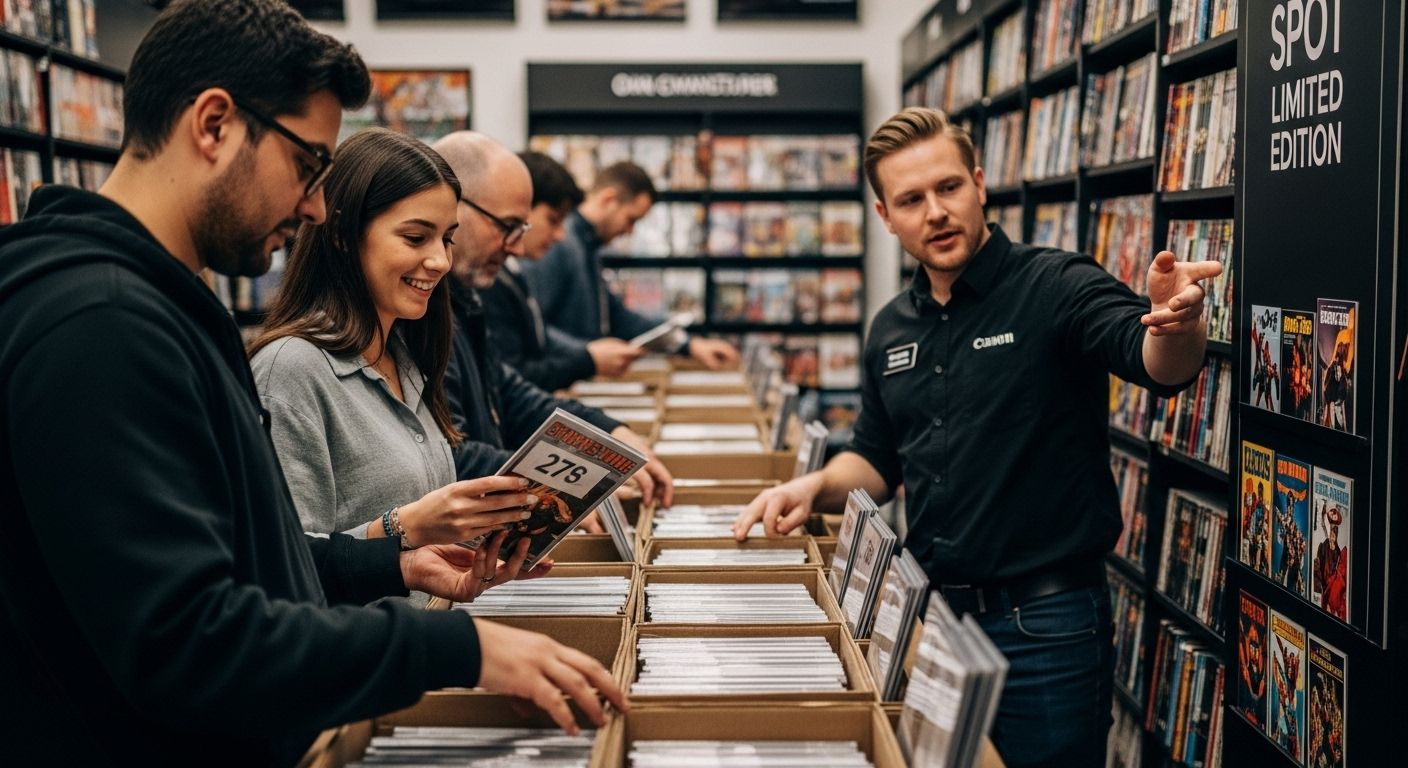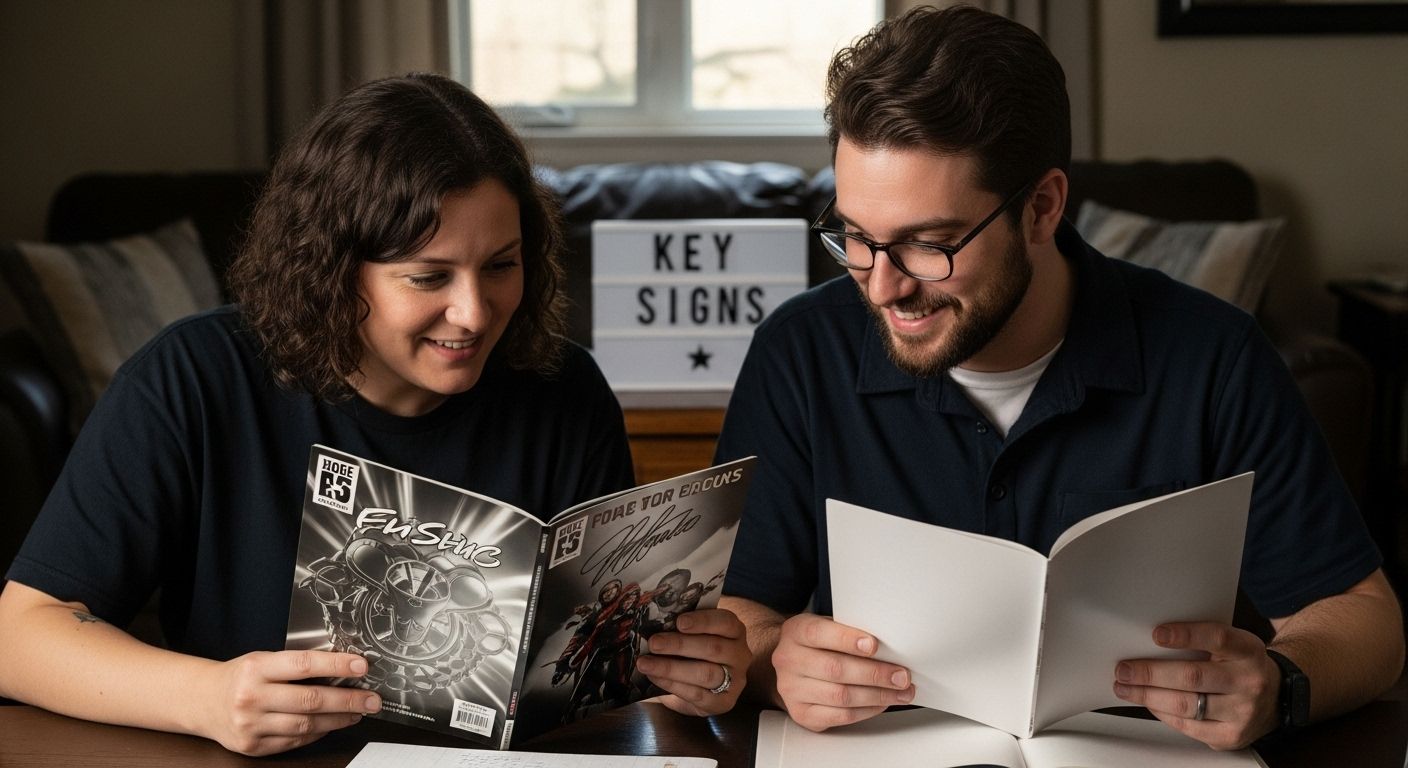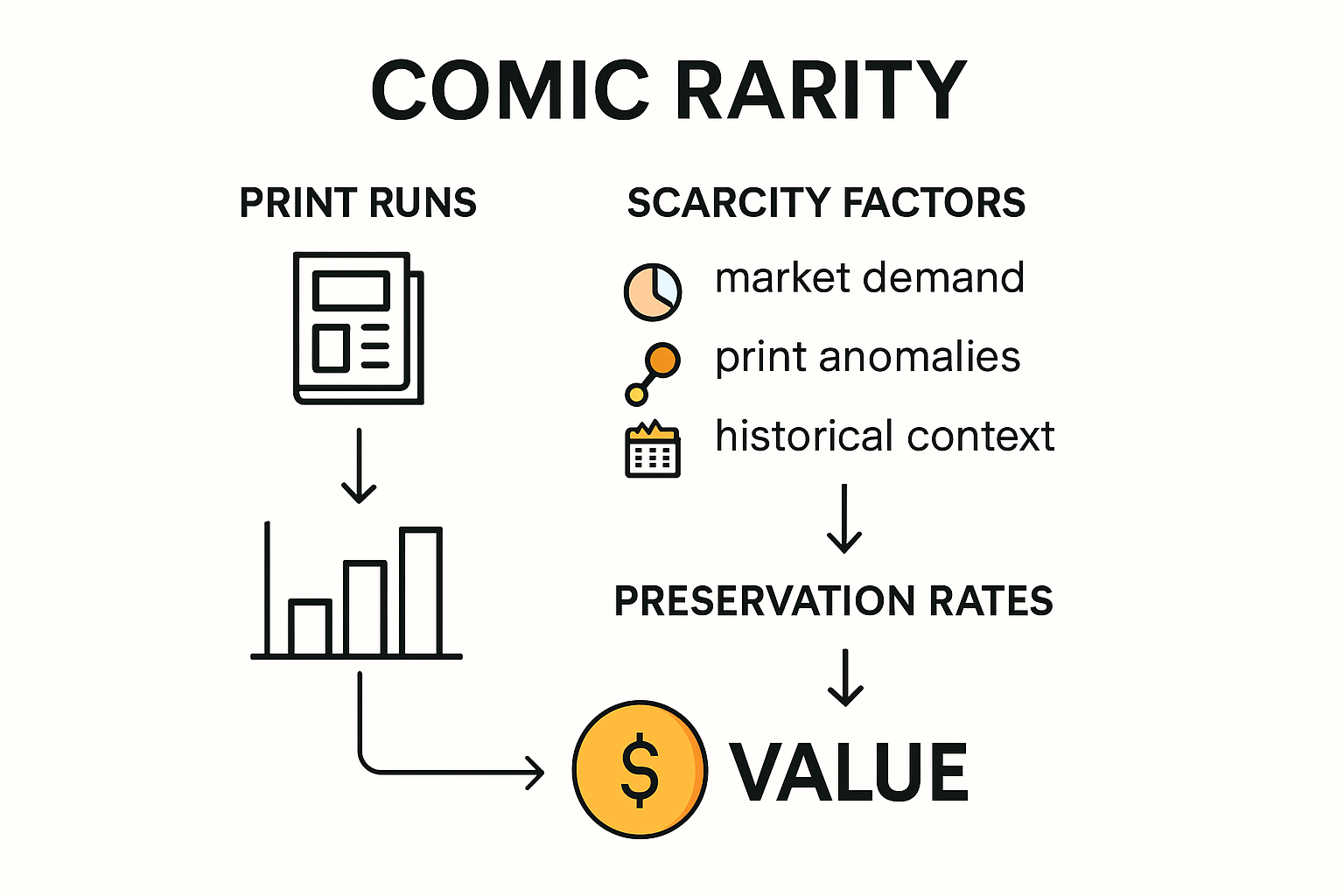How to Spot Limited Edition Comics: A Complete Guide

Comic collectors everywhere dream of finding that rare gem hidden among stacks of colorful covers and faded pages. Most think spotting a limited edition just means looking for a fancy label or a shiny cover. Yet the reality is way trickier. In fact, over 80 percent of so-called limited editions on the resale market are inaccurately labeled, missing key features like official numbering or certificates. If you think it’s just about what’s printed on the front, think again. The secrets are in the small details that even experienced collectors sometimes overlook.
Table of Contents
- Identifying Authentic Limited Edition Comics
- Key Signs And Markings To Look For
- Understanding Rarity And Print Runs
- Expert Tips For Collectors And Enthusiasts
Quick Summary
| Takeaway | Explanation |
|---|---|
| Verify print runs accurately | Check for unique numbering and low print quantities to authenticate limited editions. |
| Consider professional grading | Use services like CGC to confirm authenticity and condition of valuable comics. |
| Research historical context | Understand a comic’s background to enhance its authentication and value assessment. |
| Look for distinctive features | Identify unique cover art, embossing, and signatures that signify limited editions. |
| Develop a collection strategy | Create a focused approach that includes budgeting and long-term preservation planning. |
Identifying Authentic Limited Edition Comics
Authentic limited edition comics are prized possessions for collectors, representing rare snapshots of artistic and publishing history. Identifying genuine limited edition comics requires a strategic approach that combines expert knowledge, careful examination, and thorough research.
Verifying Print Runs and Numbering
One of the most critical aspects of identifying authentic limited edition comics is understanding their print specifications. The Library of Congress maintains extensive archives that highlight the importance of precise documentation. Authentic limited edition comics typically feature:
- Unique Numbering: Each comic should have a specific number indicating its place in the limited print run.
- Low Print Numbers: Genuine limited editions often have very low total print quantities, usually under 500 copies.
- Certificate of Authenticity: Reputable publishers provide official documentation confirming the comic’s limited status.
Collectors should carefully examine the comic’s numbering system. A legitimate limited edition will have a clear, consistent numbering sequence that matches the publisher’s official records. Handwritten or irregularly printed numbers can be red flags indicating potential forgeries.
Professional Grading and Authentication
Professional grading serves as a crucial step in verifying a comic’s authenticity and condition. The New York State Library’s Comic Book Collection demonstrates the significance of comprehensive documentation in comic preservation. Reputable grading services like CGC (Certified Guaranty Company) provide comprehensive assessments that include:
- Detailed condition evaluation
- Authenticity verification
- Preservation recommendations
- Tamper-evident sealed grading
Experts recommend having potentially valuable limited edition comics professionally graded. This process involves a meticulous examination of paper quality, print details, preservation state, and unique identifying markers.
Historical Context and Research
Understanding the historical context of limited edition comics provides additional authentication insights. The Limited Collectors’ Edition series illustrates how certain comic series were intentionally produced with restricted print runs. Collectors should:
- Research the specific publication history
- Verify the comic’s origin with official publisher records
- Compare the comic against known archival references
- Check for consistent printing techniques typical of the era
Authentication requires a comprehensive approach that combines visual inspection, historical research, and expert consultation. While no single method guarantees absolute verification, combining multiple authentication strategies significantly increases the likelihood of identifying genuine limited edition comics.
Remember that patience and thorough investigation are key. Rushing into a purchase without proper verification can result in expensive mistakes. Connecting with experienced collectors, attending specialized comic conventions, and consulting professional grading services will enhance your ability to spot authentic limited edition comics with confidence.
Key Signs and Markings to Look For
Recognizing limited edition comics requires a keen eye for specific signs and markings that distinguish these rare collectibles from standard publications. Advanced collectors develop sophisticated techniques to spot unique characteristics that signal a comic’s exceptional status.
Distinctive Cover Features
The Beinecke Rare Book & Manuscript Library highlights the importance of examining cover variations meticulously. Limited edition comics often feature unique visual markers that set them apart:
- Embossed Numbering: Hand-numbered or specially embossed edition numbers
- Variant Cover Designs: Exclusive artwork not found in standard releases
- Special Foil or Holographic Treatments: Metallic or reflective cover finishes
- Artist Signatures: Original signatures from creators or artists
Collectors should pay close attention to subtle design elements. Authentic limited editions frequently include intricate details that mass-produced comics lack. Raised embossing, special color treatments, and unique paper stocks can all indicate a comic’s limited status.
Here is a table summarizing key signs and markings that help identify authentic limited edition comics. Use this as a checklist when examining potential collectibles.
| Sign/Marking | Description |
|---|---|
| Unique Numbering | Serial number indicating a comic’s place in the print run |
| Certificate of Authenticity | Official documentation from publisher confirming limited status |
| Embossed Numbering | Hand-numbered or specially embossed edition numbers |
| Variant Cover Design | Exclusive artwork not seen in standard releases |
| Special Foil/Holographic Cover | Metallic or reflective finishes unique to limited editions |
| Artist Signature | Original signature from creator or artist |
| Publication Stamp | Official publisher’s markings |
| Special Edition Stamp | Unique identifiers from publisher indicating a special release |

Historical Publication Markers
The Comics Code Authority’s historical documentation reveals additional authentication markers. While not exclusive to limited editions, certain historical indicators can help identify rare comics:
- Publication Stamps: Official publisher markings
- Print Run Notations: Explicit mentions of limited quantities
- Special Edition Stamps: Unique identifiers from publishers
- Discontinued Seal Variations: Historical regulatory marks
These historical markers provide crucial context. Experienced collectors understand that publication stamps and special edition notations can significantly impact a comic’s collectible value. Some markers indicate specific print runs or commemorate important events in comic book history.
Comprehensive Identification Techniques
Warman’s Comic Book Field Guide recommends a multifaceted approach to identifying limited edition comics. Advanced collectors employ sophisticated identification techniques:
- Cross-reference publication records
- Examine paper quality and printing techniques
- Check for inconsistencies in standard publication formats
- Verify unique production characteristics
Authentication requires more than visual inspection. Collectors must develop a comprehensive understanding of comic book production history, printing techniques, and publication standards. Each limited edition comic tells a unique story through its physical characteristics, production methods, and historical context.
Remember that expertise comes with experience. Developing an eye for detecting limited edition comics takes time, research, and careful observation. Attend collector conventions, consult expert resources, and build relationships with experienced collectors to refine your identification skills.
Understanding Rarity and Print Runs
Rarity in comic book collecting is a complex landscape determined by intricate factors beyond simple print quantity. The Library of Congress provides crucial insights into the historical complexity of comic book publishing, revealing that true rarity involves multiple interconnected elements.
Defining Print Run Complexity
Print runs represent more than just numerical production volumes. Yale University’s Beinecke Rare Book & Manuscript Library emphasizes the nuanced nature of publication documentation. Factors influencing a comic’s rarity include:
- Initial Print Quantity: Total number of original copies produced
- Surviving Copies: Actual number of comics remaining in collectible condition
- Historical Significance: Cultural or narrative importance of the specific issue
- Printing Variations: Subtle differences between print iterations
Collectors must understand that low print numbers do not automatically guarantee high value. The comic’s condition, historical context, and collector demand play equally significant roles in determining its true rarity.
This table compares important factors that contribute to comic book rarity and scarcity, helping collectors evaluate the true value of their comics.
| Factor | Influence on Rarity | Example/Description |
|---|---|---|
| Initial Print Quantity | Lower numbers may increase rarity | Fewer than 500 initial copies |
| Surviving Copies | Fewer in good condition boosts rarity | Comics from 1930s with minimal survivors |
| Historical Significance | Important cultural or narrative role | Issue marks a major storyline event |
| Printing Variations | Rare variations/errors can increase collector value | Misprints, variant covers |
| Market Demand | High demand increases scarcity and value | Popular superhero debuts |
| Preservation Rates | Well-preserved comics are rarer | Near-mint states after decades |
| Historical Events | Publication tied to unique or commemorative events | Special anniversary issues |
Factors Impacting Comic Book Scarcity
The New York Public Library’s Rare Book Division highlights multiple dimensions of comic book scarcity. Collectors should consider:
- Preservation Rates: Percentage of comics surviving in high-quality condition
- Market Demand: Current collector interest in specific titles or characters
- Historical Events: Publication circumstances surrounding the comic’s release
- Printing Anomalies: Unexpected production variations or errors
Understanding scarcity requires deep research and contextual knowledge. Some comics become rare not because of low initial print runs, but due to unique circumstances that reduce their surviving population.
Valuation and Collector Strategies
Successful collectors develop sophisticated approaches to understanding comic book rarity. Strategic considerations include:
- Tracking historical sales records
- Studying industry publication trends
- Monitoring collector market dynamics
- Analyzing long-term preservation statistics
Rarity is not a static concept but a dynamic interplay of historical, cultural, and market forces. Collectors who comprehend these nuanced relationships can more accurately assess a comic’s true value and potential future appreciation.

Remember that expertise in understanding print runs and rarity develops through continuous learning, networking with experienced collectors, and maintaining a curious, analytical approach to comic book collecting. Each comic tells a unique story not just through its narrative, but through its entire publication history.
Expert Tips for Collectors and Enthusiasts
Navigating the world of limited edition comics requires more than just passion. Professional collectors develop sophisticated strategies that transform casual interest into serious expertise. Understanding the nuanced art of comic book collecting demands continuous learning and strategic approach.
Building a Comprehensive Collection Strategy
Successful collectors recognize that strategic planning is fundamental. Comic Book Legal Defense Fund recommends developing a methodical approach to building a collection:
- Focus Areas: Specialize in specific genres, artists, or publication eras
- Budget Management: Establish clear financial boundaries
- Long-Term Preservation: Invest in proper storage and conservation techniques
- Research Investment Potential: Track market trends and historical value trajectories
Collectors should view their collection as a curated portfolio. Each acquisition represents not just an artistic purchase but a potential long-term investment. Understanding market dynamics requires patience, research, and calculated decision-making.
Networking and Knowledge Acquisition
Comic Book Resources emphasizes the importance of community engagement. Professional collectors understand that knowledge sharing is crucial:
- Attend specialized comic conventions
- Join online collector forums
- Subscribe to industry publications
- Participate in collector workshops
- Connect with experienced dealers and appraisers
Networking provides insights beyond individual research. Experienced collectors share market intelligence, authentication techniques, and emerging trends that individual researchers might miss. Personal connections can reveal opportunities and protect against potential investment mistakes.
Advanced Authentication and Preservation Techniques
Protecting a collection requires sophisticated preservation strategies. Professional collectors invest significant effort in maintaining their comics’ condition:
- Use archival-quality protective sleeves
- Control environmental factors like temperature and humidity
- Handle comics with clean, lint-free gloves
- Implement systematic cataloging methods
- Regularly assess collection condition
Authentication goes beyond visual inspection. Advanced collectors develop relationships with professional grading services, understand detailed condition assessment criteria, and continuously educate themselves about emerging authentication technologies.
Remember that becoming an expert collector is a journey of continuous learning. No single strategy guarantees success. Approach comic collecting with curiosity, patience, and a willingness to adapt. Your collection reflects not just artistic appreciation but a deep understanding of comic book history and cultural significance.
Frequently Asked Questions
How can I verify if a comic is a genuine limited edition?
To verify if a comic is a genuine limited edition, check for unique numbering, low print numbers (generally under 500), and ensure it comes with a certificate of authenticity from a reputable publisher.
What are the key features to look for in limited edition comics?
Key features to look for include embossed numbering, variant cover designs, special foil treatments, and signatures from the artist. These distinctive characteristics can help identify limited editions from standard issues.
Why is professional grading important for limited edition comics?
Professional grading is important because it provides a detailed assessment of a comic’s authenticity and condition. Services like CGC ensure that your comic is securely preserved in a tamper-evident case, which can enhance its market value.
How does print run impact the rarity of a comic?
Print run impacts rarity by indicating the total number of copies produced. A lower print run typically increases a comic’s rarity, but factors like the condition of surviving copies and historical significance also play crucial roles in determining its overall value.
Ready to Add True Limited Editions to Your Collection?
Collectors know that finding authentic limited edition comics means more than trusting a label or a fancy cover. The real challenge is separating genuine, expertly numbered, and artist-approved issues from the sea of exaggerated claims. If you are tired of missing out on real rarities, or worried about buying a comic that falls short of your standards for quality, authenticity, and provenance, you are not alone. The techniques you learned in this guide—like checking print runs, looking for certificates of authenticity, and verifying unique cover features—are all essential for making smart collecting decisions.

Now you can turn that knowledge into action by exploring The Mansion Press. Our online store brings together limited edition comics, artist-signed artbooks, and exclusive collector’s items that meet the very standards outlined in your guide. Every listing provides detailed descriptions, clear visuals, and information about print runs or edition size so you can buy confidently. Start browsing at The Mansion Press today and secure your next authentic collectible while supplies last. If you want to deepen your expertise, keep an eye on our site for upcoming limited pre-orders and original art releases that you will not find anywhere else.

